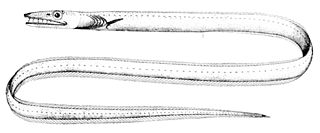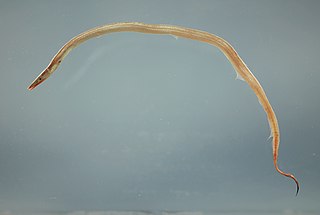Hoplunnis is a genus of eels in the duckbill eel family Nettastomatidae. It currently contains the following species:
The flapnose conger is an eel in the family Congridae. It was described by David G. Smith and Robert H. Kanazawa in 1977. It is a tropical, marine eel which is known from French Guiana, in the western central Atlantic Ocean. It is known to dwell at a depth of 210 metres.
Acromycter atlanticus is an eel in the family Congridae. It was described by David G. Smith in 1989. It is a marine, deep water-dwelling eel which is known from the western central Atlantic Ocean. It dwells at a depth range of 503–640 meters. Males can reach a maximum total length of 29.5 centimeters.
The Bullish conger is an eel in the family Congridae. It was described by David G. Smith and Robert H. Kanazawa in 1977, originally under the genus Rhechias. It is a marine, deep water-dwelling eel which is known from the Gulf of Mexico to the Amazon, in the western Atlantic Ocean. It dwells at a depth range of 366–475 meters. Males can reach a maximum total length of 39.5 centimeters.
Xenomystax austrinus is an eel in the family Congridae. It was described by David G. Smith and Robert H. Kanazawa in 1989. It is a marine, deep water-dwelling eel which is known from the western central Atlantic Ocean. It is known to dwell at a depth range of 458 to 732 meters.

The bristletooth conger is an eel in the family Congridae. It was described by David G. Smith and Robert H. Kanazawa in 1989. It is a marine, deep water–dwelling eel which is known from the western Atlantic Ocean, including northeastern Florida, U.S.A.; the Gulf of Mexico, the Amazon River, the Bahamas and the West Indies. It dwells at a depth range of 140–825 metres (459–2,707 ft). Males can reach a maximum total length of 87.6 centimetres (34.5 in).

The yellow garden eel is an eel in the family Congridae. It was described by David G. Smith in 1989. It is a nonmigratory marine, tropical eel which is endemic to waters off the coast of the U.S. state of Florida. It is known from the both sides of Florida, from the Gulf of Mexico to the western central Atlantic Ocean. It is known to dwell at a depth of 33 m (108 ft).

The blacktail pike-conger is an eel in the family Nettastomatidae. It was described by George Brown Goode and Tarleton Hoffman Bean in 1896. It is a subtropical, marine eel which is known from the western Atlantic Ocean. It is known to dwell at a maximum depth of 203 meters. Males can reach a maximum total length of 36.6 centimeters.

The freckled pike-conger, also known as the silver conger, is an eel in the family Nettastomatidae. It was described by Isaac Ginsburg in 1951. It is a marine, subtropical eel which is known from the western central Atlantic Ocean, including the Gulf of Mexico, Colombia, and towards the mouth of the Amazon River. It dwells at a depth range of 55–310 meters. Males can reach a maximum total length of 54.2 centimeters.
The silver pikeconger is an eel in the family Nettastomatidae. It was described by E. David Lane and Kenneth W. Stewart in 1968. It is a marine, tropical eel which is known from the eastern Pacific Ocean. Males can reach a maximum total length of 125 centimetres (49 in), but more commonly reach a TL of 60 centimetres (24 in).
The slender duckbill eel is an eel in the family Nettastomatidae. It was described by Charles Tate Regan in 1915. It is a marine, deep water-dwelling eel which is known from the Gulf of Guinea, in the eastern Atlantic Ocean. It inhabits the continental shelf and slope. Males can reach a maximum total length of 55.5 centimetres (21.9 in).
Hoplunnis schmidti is an eel in the family Nettastomatidae. It was described by Johann Jakob Kaup in 1860. It is a marine, tropical eel which is known from Venezuela, in the western central Atlantic Ocean.
Hoplunnis sicarius is an eel in the family Nettastomatidae. It was described by Samuel Garman in 1899, originally under the genus Atopichthys. It is a marine, tropical eel which is known from the eastern central Pacific Ocean, including Mazatlan, Mexico, and Panama. It is known to dwell at a depth of 1,431 metres (4,695 ft), and inhabits substrates. Unlike many eel species, it does not form burrows.
Hoplunnis similis is an eel in the family Nettastomatidae. It was described by David G. Smith in 1989. It is a marine, deep water-dwelling eel which is known from the western central Atlantic Ocean, including Florida, USA, Honduras and Nicaragua. It is known to dwell at a depth range of 146 to 329 meters. Males can reach a maximum total length of 49.3 centimeters (19.4 in).
The spotted pike-conger, also known as the conger eel in Cuba, is an eel in the family Nettastomatidae. It was described by Isaac Ginsburg in 1951. It is a marine, deep water-dwelling eel which is known from the western Atlantic Ocean, including the Gulf of Mexico and the Straits of Florida, USA. It dwells at a depth range of 130 to 420 meters, and inhabits benthic sediments of mud. Males can reach a maximum total length of 46 centimeters (18 in).
The pygmy pikeconger or pygmy duckbill eel, is an eel in the family Nettastomatidae. It was described by David G. Smith and James Erwin Böhlke in 1981. It is a marine, tropical eel which is known from the western central Atlantic Ocean, including Venezuela and the Gulf of Mexico, and possibly more locations. It is known to dwell at a depth range of 128 to 280 meters. Males can reach a maximum total length of 20.1 centimeters (7.9 in).
The longface eel is an eel in the family Nettastomatidae. It was described by David G. Smith in 1989. It is a marine, tropical eel which is known from the western central Atlantic Ocean, including North Carolina and Florida, USA, the northwestern Gulf of Mexico, and Mobile Bay. It dwells at a depth range of 59 to 158 meters. Males can reach a maximum total length of 36 centimeters (14 in).
Callechelys catostoma, the black-striped snake eel or dark band snake eel,) is an eel in the family Ophichthidae. It was described by Johann Gottlob Theaenus Schneider and Johann Reinhold Forster in 1801. It is a tropical, marine eel which is known from the Indo-Pacific, including the Red Sea, East Africa, the Society Islands, the Ryukyu Islands, and Lord Howe Island. It dwells at a depth range of 1–32 metres, and inhabits reefs. It burrows into loose gravel and sand. Males can reach a maximum total length of 85 centimetres (33 in).
Avocettina paucipora is an eel in the family Nemichthyidae. It was described by Jørgen G. Nielsen and David G. Smith in 1978. It is a marine, temperate water-dwelling eel which is known from the southwestern Atlantic, southern Indian, and the Pacific Ocean. They can reach a maximum total length of 55 centimetres.
Nemichthys larseni is an eel in the family Nemichthyidae. It was described by Jørgen G. Nielsen and David G. Smith in 1978. It is a marine, deep water-dwelling eel which is known from the eastern Pacific Ocean, including Oregon and Hawaii, USA, Mexico, and the Gulf of California. It dwells at a depth range of 0 to 1,000 metres. Males can reach a maximum total length of 161 centimetres (63 in).



